The School of Arts in Boundary Street, West End, played an important role in the community for 80 years. Today it is all but forgotten. However, the Kurilpa Library, built as an extension to the School of Arts in 1928, continues this 130 year old tradition.
The School of Arts movement
The industrial revolution created a need for the technical education of workers. There was also a growing interest in science and technology. This gave rise to the School of Arts movement in which purpose built buildings were constructed by local communities and used for classes, public lectures, libraries and general community use. Manual workers or artisans were known as mechanics, resulting in the alternate common name of Mechanics' Institutes.

The first such organisation was founded in Edinburgh in 1821 and the idea quickly spread around the English speaking world. The Hobart Mechanics' Institute was founded in 1827 with a Sydney Institute following six years later. The Brisbane School of Arts was founded in 1849. In response to Brisbane's rapid population increase, a number of others were established in the 1880s, including at West End.
The beginnings
A small group with this aim in mind met towards the end of 1886. Two of them, John Hardgrave and Phillip Nott, were members of the local council, at that time the Woolloongabba Divisional Board, which no doubt assisted getting support from that body.
The Board agreed to borrow the funds for construction from the Colonial Treasury and to sell the vacant land it had on Boundary Street. This was all to be repaid by the committee within 10 years. At least 7 approved residents were to guarantee repayment, which was to come from leasing the rooms in the building. As well, a threshold of 75 subscribers had to be met to raise money for the fit out. One thousand handbills were printed for distribution around the surrounding suburbs to raise the required interest.
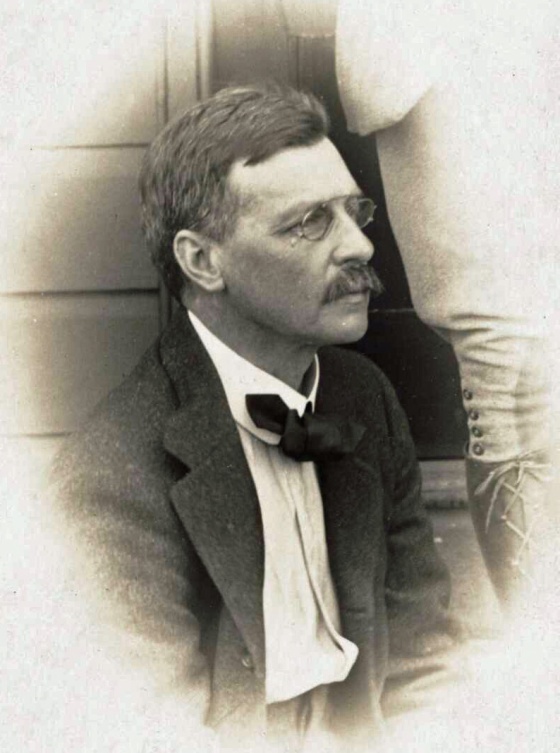 John Smith Murdoch (National Library of Australia)
John Smith Murdoch (National Library of Australia)
The building was designed by the architect John Smith Murdoch. His other works include the South Brisbane Municipal Chambers and Brisbane's ANZAC Square and he also designed many of Canberra's early buildings, including old Parliament House.
The West End School of Arts was a two floor brick structure featuring an expansive hall seating 450 and 5 meeting rooms on the ground floor. On the second floor were another two large meeting rooms. The total liability was almost £3,300, which was to cause problems in the future.
Construction was completed in January of 1889. The mayor agreed to open the building but inexplicably didn't turn up. Andrew Thynne, who was attending, stepped in to perform the job. He was a lawyer, a member of the upper house of Parliament and Minister for Justice, and lived nearby in Blakeney Street. After his impromptu speech, there was a " programme of recitations, glees, instrumental and vocal selections rendered by several ladies and gentlemen". This was followed by dancing until the early hours of the morning.
The 1890s crisis
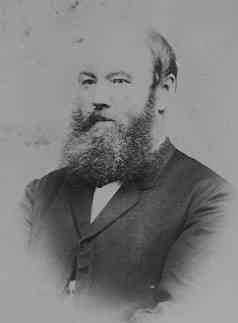 John Hardgrave, a former mayor of Brisbane, was one of the seven guarantors of the original loan to establish the School of Arts who forfeited £100 each. (State Library of Queensland)(ancestry.com)
John Hardgrave, a former mayor of Brisbane, was one of the seven guarantors of the original loan to establish the School of Arts who forfeited £100 each. (State Library of Queensland)(ancestry.com)
Despite some income from the hiring of rooms by community groups, repayments to what was by then the South Brisbane Municipal Council fell behind. The Council agreed to take over the building, expunge the debt and rent it back to the management committee for £4 a month.
However, the financial problems continued. In 1895, the water was cut off due to non payment and the gas supply, essential for lighting, was constantly at risk due to overdue bills. Mayor Fish was pushing for eviction and sale of the building, as the rental was also well in arrears. He was opposed by management committee member and alderman John Hardgrave who countered that the Council had not undertaken essential repairs.
Following a public crisis meeting in 1897, a new committee with two aldermen and others elected by subscribers was established and the situation slowly improved.
The library
 The Moreton Mail, 19th July 1889. (Trove)
The Moreton Mail, 19th July 1889. (Trove)
A key facility of a school of arts was the provision of a lending library, open to subscribers and aimed at the facilitation of self improvement and education. In January of 1889, Annie Eliza Suter was appointed as the librarian and secretary.
The library opened a few months later and in the first year there were around 200 subscribers and some 700 volumes on the shelves. These were a mixture of purchased and donated books.
Despite the original rationale for the library, the predominant demand was for works of fiction with a very small number of technical books borrowed.
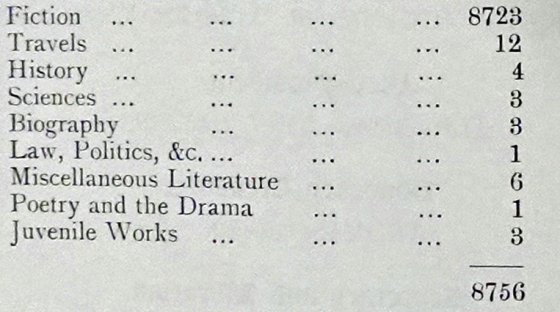 Books lent during 1901 by category. (West End School of Arts annual report, Queensland State Archives)
Books lent during 1901 by category. (West End School of Arts annual report, Queensland State Archives)
Annie Suter, later Preston, left the job of secretary in 1894. She later lived for many years in Sri Lanka, where in 1922 she was the first principal of the Nursery section of Massaeus College in Colombo which was run on Montessori and Theosophical principles.
In 1897 a free reading room was opened, although books could still only be borrowed by subscribers. The purchase of books continued over the years with funds raised by the committee. In 1919, a council inspector found that the well patronised library was overcrowded with no room for expansion. Land adjoining the School of Arts was resumed and a new library building planned.
Work had not commenced by the time that the South Brisbane Council was absorbed into the new Greater Brisbane City Council in 1925. The South Brisbane Council had been unusual in Brisbane in that it directly ran both the South Brisbane and West End libraries. The new council had a preference for the various Schools of Arts around Brisbane to continue in their traditional provision of book lending facilities.
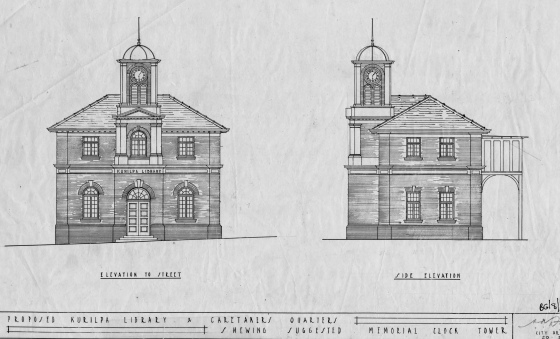 The Kurilpa Library plan in 1927. (Brisbane City Council)
The Kurilpa Library plan in 1927. (Brisbane City Council)
At the same time, the Kurilpa War Memorial Ladies' Committee had decided to provide a set of clock chimes to serve as the district's memorial (see my post Lest We Forget – Highgate Hill ) The clock would be housed in a tower added to the library design.
 Work underway on the library. The original School of Arts building is at the left. (Brisbane Courier 1st August, 1928, State Library of Queensland)
Work underway on the library. The original School of Arts building is at the left. (Brisbane Courier 1st August, 1928, State Library of Queensland)
The Council eventually agreed to fund the building, complete with tower, and the committee provided the clock with chimes and an honour board located in the entrance. It was completed in 1929 and was the first purpose built municipal library in Queensland.
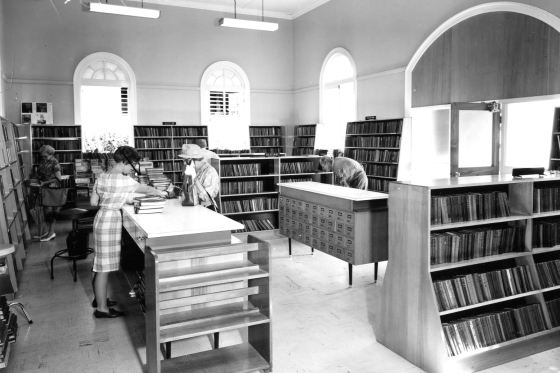 The Kurilpa Library in 1964. (Brisbane City Council)
The Kurilpa Library in 1964. (Brisbane City Council)
It wasn't until the late 1940s that the Brisbane City Council began to take over the remaining suburban School of Arts libraries, plan new purpose built library buildings and remove lending fees. Today over 130 years after its establishment, the Kurilpa Library remains in use. The memorial chimes can be heard through the day.
The library in 1949 with the School of Arts next door and in 2021.
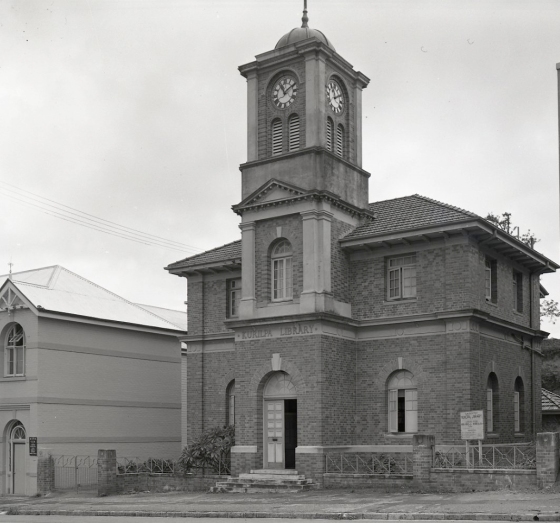
The Library and School of Arts in 1949. (Brisbane City Council)

Kurilpa Library in 2021. (P. Granville)
Education and the technical college
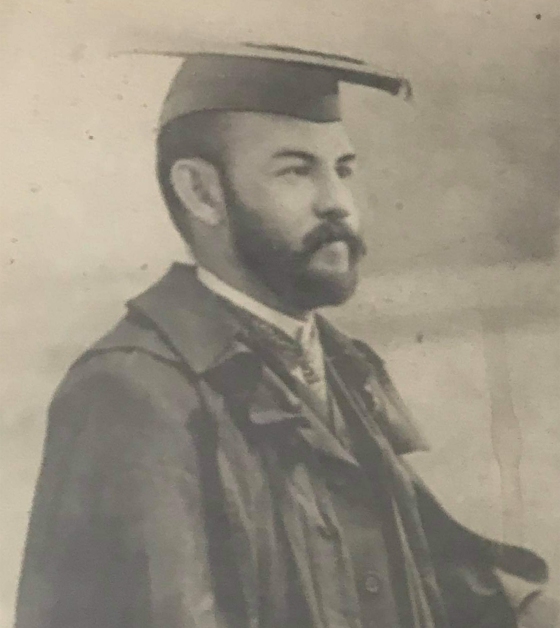 Richard Kelly. (Courtesy of Kelly family)
Richard Kelly. (Courtesy of Kelly family)
One of the prime functions of a school of arts was education. Soon after the opening, Richard Kelly rented space to give night classes at West End. They were targeted at people wishing to pass examinations for recruitment and promotion in the civil service and included subjects such as Latin, Greek, arithmetic, shorthand and other business subjects.
Mr. A. Kay was giving singing lessons and a short time later Miss Temple began elocution classes. In 1891, it was the only institution other than the Brisbane Technical College offering further education.
The Queensland Government had a system of grants to encourage the establishment and expansion of technical colleges, however an application in 1890 was knocked back due to West End's proximity to the Brisbane college. It finally began to receive funding in 1899. Kelly's classes were incorporated into the technical college, which meant that the government made endowment payments based on the fees he received from students.
 Courses offered by the West End School of Arts in 1889.(Technical and Further Education in Queensland)
Courses offered by the West End School of Arts in 1889.(Technical and Further Education in Queensland)
In 1904 a new secretary, Miete Struver, commenced work. She was confused by the reporting to the Government and there had been no handover when she commenced, so she sought help from the Department of Public Instruction. They soon found serious anomalies with claims by Richard Kelly far greater than had been paid by pupils. This inflated the endowment payments made by the Government.
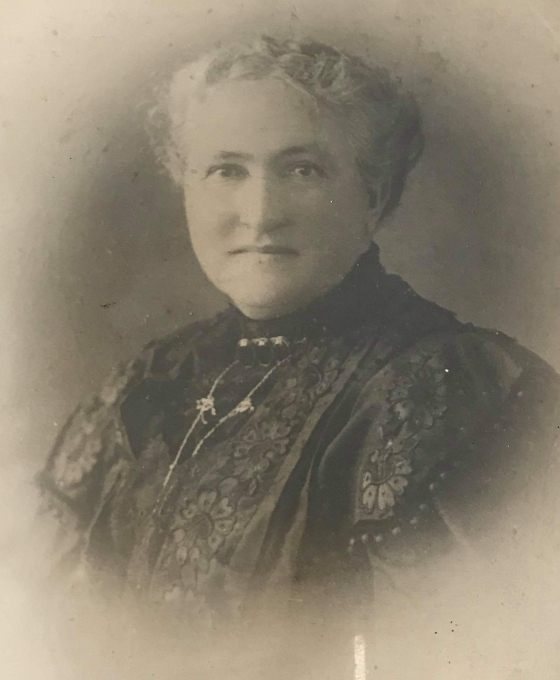 Maria Kelly. (Courtesy of Kelly family)
Maria Kelly. (Courtesy of Kelly family)
Kelly's wife Maria, also a teacher, was running the business classes, ostensibly employing her husband. The agreement with the management committee was that the Kellys would receive all fees paid by pupils, plus half of the associated endowment payments. The Department noted that their approval for the Kellys to be appointed as teachers had not been sought. This approval was not forthcoming and a large endowment claim was rejected.
By this time, the Kellys had started their own successful college in the city. You can read about subsequent events in my post The Mistress’s House.
 The West End School of Arts in 1907. (From the college letterhead, Queensland State Archives)
The West End School of Arts in 1907. (From the college letterhead, Queensland State Archives) Vida Lahey in 1924. (State Library of Queensland)
Vida Lahey in 1924. (State Library of Queensland)
Under a new committee, the college expanded its areas of instruction. By 1907, classes included painting, technical drawing, staircasing and handrailing, carpentry and joinery, school revision, applied mechanics, shorthand, typewriting, bookkeeping, business methods, cookery, millinery, ironing and starching, and dressmaking.
In that year a 25 year old Vida Lahey, who had just completed two years study at the National Gallery School, Melbourne, commenced work as an instructor. As well as her work as an artist, she is remembered today for her life long interest in teaching and support of art in Queensland. She remained an instructor at West End for several years.
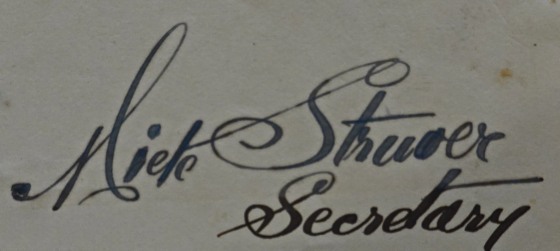 Miete Struver's elegant signature. (Qld. State Archives)
Miete Struver's elegant signature. (Qld. State Archives)
An inspector's report from 1907 described the college as being financially successful, mainly due to the efforts of secretary Miete Struver in attracting both instructors and pupils. He noted that facilities and space were somewhat lacking, making it difficult to compete with the two larger nearby colleges at South Brisbane and in the city.
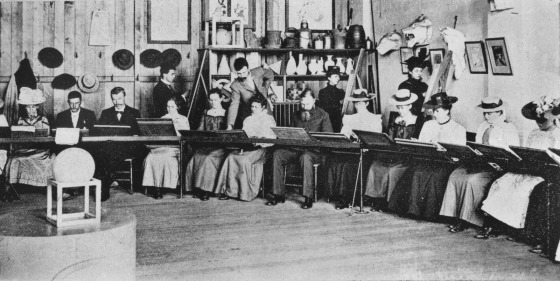 A drawing class at the Brisbane School of Arts, 1901. (State Library of Queensland)
A drawing class at the Brisbane School of Arts, 1901. (State Library of Queensland)
In that year, Attorney-General James Blair introduced a bill in Parliament which was aimed at rationalising technical education. In particular, the Brisbane colleges were to be folded into one central institution under direct government control, providing a model for others in the State. This amalgamation was implemented in 1910 and the West End College closed.
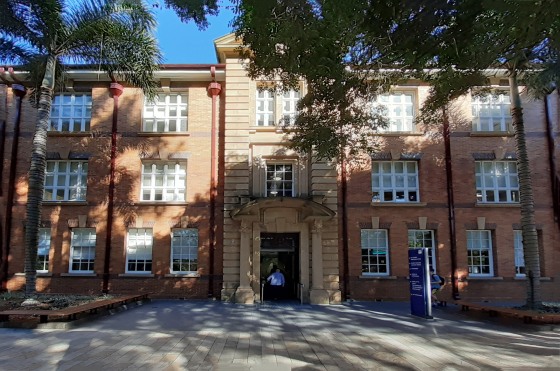 "A Block" of the Brisbane Central Technical College was one of 9 buildings constructed from 1911. Completed in 1915, it now forms part of QUT. (P. Granville)
"A Block" of the Brisbane Central Technical College was one of 9 buildings constructed from 1911. Completed in 1915, it now forms part of QUT. (P. Granville)
Friendly Societies
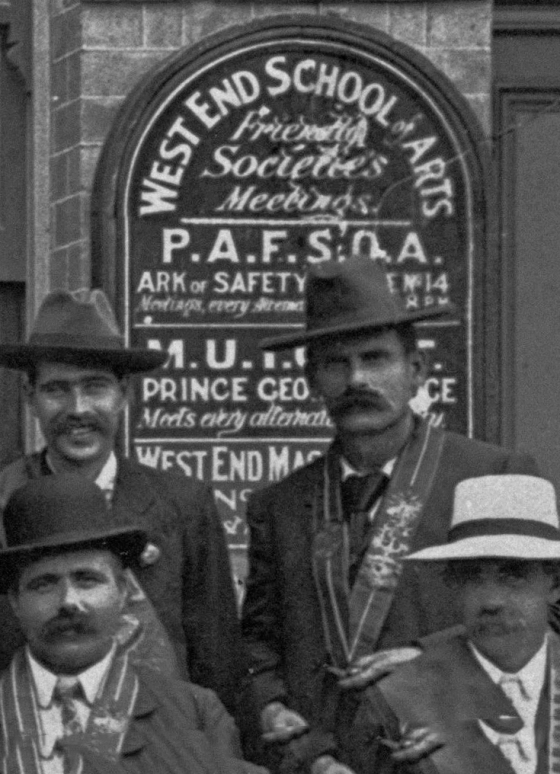 The West End Friendly Society notice board with Society members, 1902. (State Library of Queensland)
The West End Friendly Society notice board with Society members, 1902. (State Library of Queensland)
Friendly Societies, whilst having their roots in medieval craft guilds, came into their own in the 19th century. British based societies were transported to Australia where they flourished. They provided financial assistance to members and their families in times of lack of income due to causes such as injury, sickness, death or loss of tools.
By 1901, around one quarter of Queenslanders was covered by Friendly Society protection. With their large membership base, they had significant political influence.
Friendly Societies had many local chapters and often used similar trappings to lodges such as regalia, secret passwords and handshakes. In the same period, temperance societies, often linked to non-conformist religions, also became popular.
The West End School of Arts was designed with these groups in mind, with 7 meeting rooms. One of the first to utilise the new facilities was the Loyal Prince George Lodge of the Manchester Unity Independent Order of Oddfellows. A ball held in the hall in August of 1889 was attended by 200 and dancing continued until 5am the next morning. The building was obviously filling a need!
 The description of the women's dresses in this article went for two columns. (Queensland Figaro and Punch, 3rd August. 1889. (Trove)
The description of the women's dresses in this article went for two columns. (Queensland Figaro and Punch, 3rd August. 1889. (Trove)
Others who met in the School of Arts over the years included the Ark of Safety Tent of the Rechabites, the Light of West End Lodge of the Good Templars, the Juvenile Lodge of Hope of South Brisbane, Court Stanley of the Ancient Order of Foresters and the Mistletoe Lodge of the United Order of Druids. The latter appear particularly odd to modern eyes, as in parades they often wore gowns and fake beards.
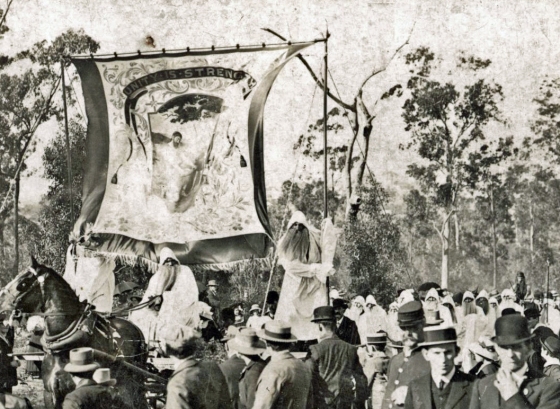 Druids on parade in Newcastle, 1911.(caolandcommunity.com)
Druids on parade in Newcastle, 1911.(caolandcommunity.com)
Over time, many of the welfare functions of friendly societies were taken over by Government and membership gradually dropped off through the 20th century. Some still exist as companies providing financial services and private medical insurance.
 A Friendly Society group in front of the West End School of Arts, 1902. (State Library of Queensland)
A Friendly Society group in front of the West End School of Arts, 1902. (State Library of Queensland)
Political meetings
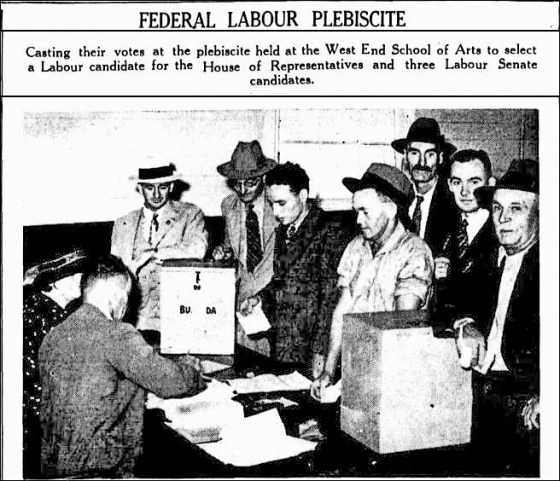 Telegraph, 27th February 1937. (Trove)
Telegraph, 27th February 1937. (Trove)
The School of Arts was always a popular venue for political meetings. For example, 1889 saw over 300 at a gathering organised by the Anti-Convention Bill League, that opposed Queensland joining the proposed Commonwealth of Australia. When 3 people present indicated their support for federation in a show of hands, they were met with groans.
In 1923 the Premier, "Red Ted" Theodore, was in the hall at another large meeting defending his government against attacks regarding the influence of communists on Labor Party policy. Meetings associated with federal, state and council elections continued over the years.
 Rowdy political meetings at the West End School of Arts. (Trove)
Rowdy political meetings at the West End School of Arts. (Trove)
At times, meetings were heated. A speech by David Hunter, the Liberal candidate for the Federal seat of Oxley in 1913 "for the most part was a contest in lung power and repartee between him and the rowdy element.". A Mr. Murphy was ejected by the police and 'a number of men and women, youths and girls" left in protest, leaving the hall quiet. Before long, they all returned along with the noise.
In 1938, Joseph Moore, the Protestant Labour Party candidate for the State seat of Kurilpa was trying to speak above the "clamourous roar of interjections, cat calls, women's shrieks, and boo hoos" when a brawl broke out between his supporters and others. The police managed to separate the combatants and the meeting continued.
Community use
The facilities provided by the School of Arts were used frequently by a wide variety of community and private groups. The various room sizes available meant that events from the very small to the large could be catered for, with Kurilpa Hall, as it was known from 1922, able to seat 450.
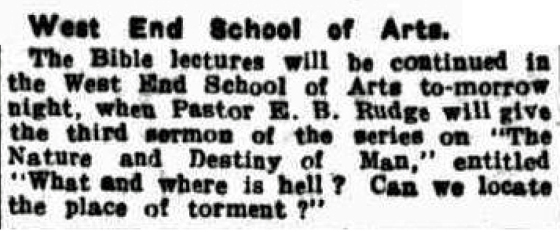 "What and where is hell?" Brisbane Courier, 26th January 1918. (TROVE)
"What and where is hell?" Brisbane Courier, 26th January 1918. (TROVE)
The facilities often proved invaluable when the community organised support for families in need. A tragic example is that of James Jackson, a grave digger, who drowned in the 1890 flood while trying to collect pumpkins floating down the river.
His destitute widow, who had 4 daughters under 7 years old, expressed a desire to return to England as she had no family in Australia. The fare was raised through various activities, including a concert held at the School of Arts. Then fate took a cruel turn, as on their journey home a month later, the family drowned along with 129 others in the Quetta disaster.
 The large hall accommodated events such as the annual West End State School fancy dress ball, pictured here in 1935. (Daily Standard 12th August 1935. Trove)
The large hall accommodated events such as the annual West End State School fancy dress ball, pictured here in 1935. (Daily Standard 12th August 1935. Trove)
The building hosted club meetings, drama and musical group performances, dances, eisteddfods, air raid warden meetings during World War 2, wedding receptions, private parties and fetes. The images from newspapers below are a sample of these : Eisteddfod competitors in 1937, a 1954 charity wrestling match, amateur theatrics in 1939, a 1954 spelling bee, and a wedding in 1946.

Kurilpa Eisteddfod competitiors, Telegraph 30th July 1937. (Trove)

Telegraph, 20th October 1954. (Trove)

Telegraph, 3rd May 1939. Trove

Telegraph 6th April 1954. (Trove)
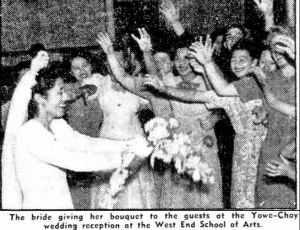
Sunday Mail, 27th January 1946. (TROVE)
The child care centre
During World War 2, the need for child day care centres rose rapidly. With large numbers of men in the armed forces, many women entered the workforce and also became sole carers. A group of local women determined to establish a centre and lobbied the mayor, John Chandler, for assistance. Prominent in this group was Elsie Lane nee Smith, a committed communist. She married the boy next door in Dauphin Terrace, Ted Lane son of Mabel and Ernie Lane (see my post Ernie and Mabel Lane – Radical Activists ). They spent their married life living in a house they built in the same street.
The mayor agreed to the use of the School of Arts building, initially free of charge, on the proviso that Elsie did not continue as member of the child care committee due to her political beliefs. The Kurilpa Child Care Centre commenced operation in 1944.
 The playground was in the small space behind the School of Arts hall. Image ca. 1949. (kurilpaccc.org.au)
The playground was in the small space behind the School of Arts hall. Image ca. 1949. (kurilpaccc.org.au)
The centre accepted children of all ages and was run independently by community members. A feature over the years was always to provide meals and a nursing sister was also employed during the 1960s and 70s.
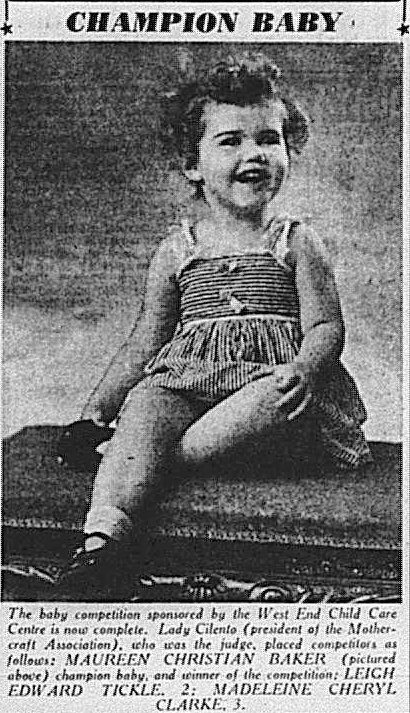 Telegraph, 14th November 1947. (Trove)
Telegraph, 14th November 1947. (Trove)
A notable figure in the centre's history is Gladys Midwinter, who served initially as a volunteer and later as director, working at Kurilpa for almost 30 years. She was awarded an OBE in 1985 for her community service .
With no external financial support, fund raising activities such as a weekly jumble sale and baby competitions were essential and there was also support from some local businesses. The facilities were not ideal and the building was shared with numerous other users. By 1961, there were some 91 children enrolled.
With these deficiencies, the committee at the time worked to obtain an adjoining block of land which the City Council made available for £2,600. It was purchased in 1960 and a new building was completed in 1963. With rising levels of regulation, by the 1990s this building in turn became impractical to update and the centre sold the by then very valuable land and purchased an existing centre in Gray Road, West End where they still operate today.
Our daughter's pre-school group in 1995 and the location of the Child Care Centre from 1963 to 1998.
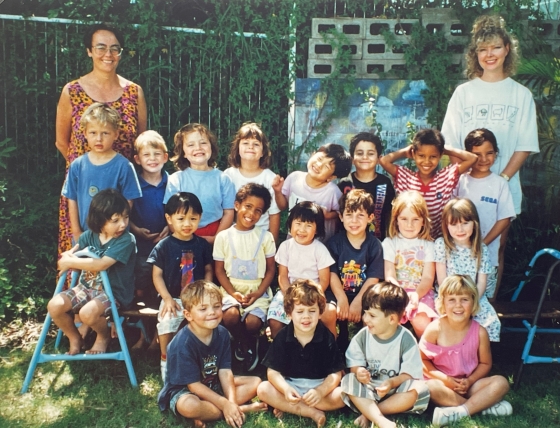
Our daughterls pre-school group 1995.
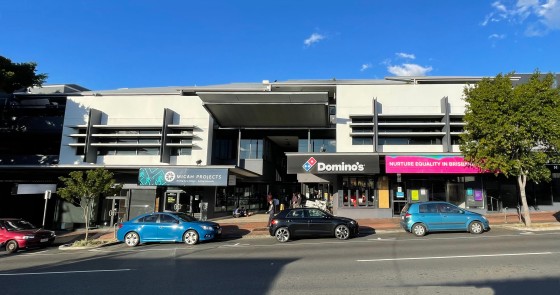
The location of the Kurilpa Child Care Centre (P. Granville)
The end
The aerial image below, taken in 1961, shows both the School of Arts and the nearby Lyric Theatre which was demolished some time later (see my post Tom Garrick, Cinema Pioneer).
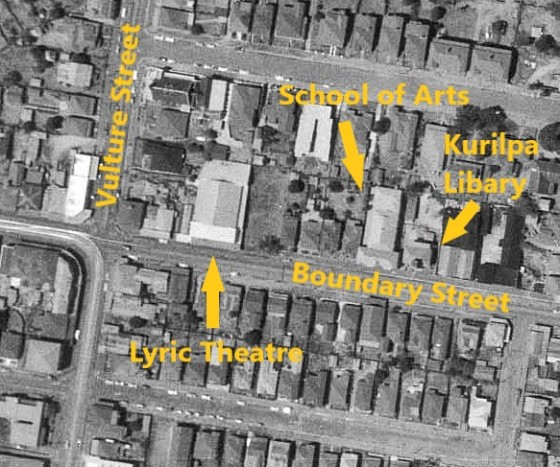 Aerial image from 1960. (QImagery)
Aerial image from 1960. (QImagery)
In May 1968, an arsonist set fire to the old School of Arts building. Luckily no one was injured but what was left, along with an adjoining house, had to be demolished. A building which would have continued to provided a valuable community resource into the future was lost. In its place now stands the headquarters of the Australian Pensioners and Superannuants League Queensland Ltd. where facilities are available for community use, in the tradition of the old School of Arts.
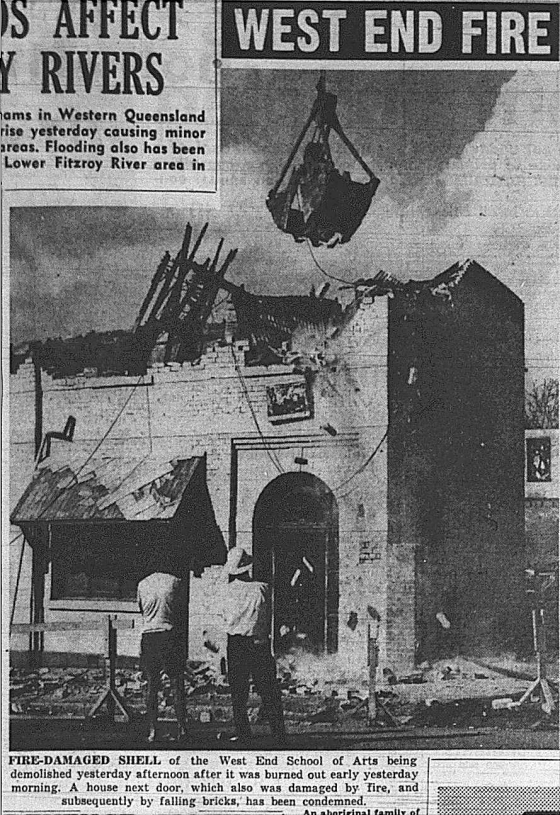 Courier-Mail, 3rd May 1968. (State Library of Queensland)
Courier-Mail, 3rd May 1968. (State Library of Queensland)



